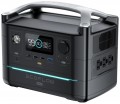Connecting an additional battery
Ability
to connect an external battery to the charging station to increase the overall energy consumption and, as a result, extend the battery life. This connection is fast and convenient. On the other hand, the battery takes up extra space on the outside, making the whole structure more cumbersome.
Battery capacity
Nominal
battery capacity, in fact - the amount of energy that is supposed to be stored. The larger it is, the longer the battery life of the charging station will be, all other things being equal. On the other hand, this parameter also affects the dimensions, weight and price of the battery, despite the fact that an energy-intensive battery is not always required. By the indicator of capacity in watt-hours, you can compare batteries with each other.
Charging cycles
The number of charge-discharge cycles that the battery can withstand without significant loss of performance.
In the process of operation, the batteries wear out, which causes their performance to suffer (in the first place, the capacity decreases). Battery life is usually measured in charge-discharge cycles. However, models with the same declared resource are not always equally durable in practice. Different manufacturers may interpret “significant loss of performance” in different ways: for example, one brand indicates the resource up to a 20% decrease in capacity (DOD > 80%), another - up to a 60% decrease (DOD > 40%) Behind the abbreviation DOD worth decoding Depth of Discharge, i.e. discharge depth. Therefore, when choosing, it makes sense to focus not only on pure numbers, but also on other sources - test results, reviews, etc. Also note that battery life can be noticeably reduced if the operating conditions are violated (for example, in case of overheating or hypothermia).
Charging time (solar panel) ≈
Time spent on a full charge when using the original panel in bright sunlight. In cloudy weather, the charging time of the device from the solar panel can be strikingly different downwards.
Charging time (cigarette lighter) ≈
The time required to fully (from zero to 100%) charge the battery, provided that power is supplied to the charging station from the car's cigarette lighter socket (12 V).
Charging power (socket)
The power at which, in normal mode, the portable power station is charged from a household outlet when using the original power supply.
Charging power (solar panel)
The power in watts provided when charging a device from a solar panel.
The higher the charging power, all other things being equal, the less time it will take to replenish the energy reserves in the cells of the device's own battery. This section provides the maximum power value that the charging station can accept. Accordingly, this indicator is supposed to be taken into account when choosing compatible solar panels.
Smartphone synchronization
Synchronization with a smartphone allows you to control the operation of the charging station remotely. Pairing the device with mobile gadgets is carried out via a Wi-Fi network or a Bluetooth connection. Some charging stations provide both of the above wireless modules. Additionally
, synchronization with a smartphone allows you to monitor battery charge, energy consumption, voltage and current parameters remotely in real time. This will require a permanent connection to the Internet and specialized software that must be installed on your smartphone.

